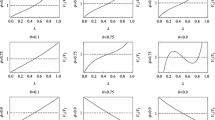Abstract
This paper deals with the provision and finance of local public goods, where free riding across communities emanates from interjurisdictional commuting. In a two-city model with inter-city commuting incorporated, the relationship between a market equilibrium and an optimizing solution is investigated. Instruments for achieving Pareto-efficient locations, production and commuting are proposed.
Similar content being viewed by others
References
Arnott RJ (1979) Optimal city size in a spatial economy. J Urban Econ 6:65–89
Arnott RJ, Stiglitz JE (1979) Aggregate land rents, expenditure on public goods, and optimal city size. Q J Econ 93:471–500
Berglas E, Pines D (1981) Clubs, local public goods and transportation models: a synthesis. J Publ Econ 15:141–162
Carlio GA (1979) Increasing returns to scale in metropolitan manufacturing. J Reg Sci 19:363–379
Flatters F, Henderson V, Mieszkowski P (1974) Public goods, efficiency, and regional fiscal equalization. J Publ Econ 3:99–112
Henderson VJ (1985) Economic theory and the cities, 2nd edn. Academic Press, New York
Hochman Oded (1981) Land rents, optimal taxation and local fiscal independence in an economy with local public goods. J Publ Econ 15:59–85
Oakland WH (1972) Congestion, public goods and welfare. J Publ Econ 1:339–357
Sakashita N (1988) Spatial interdependence and externalities. Discussion Paper Series No. 391 Institute of Socio-Economic Planning, University of Tsukuba
Sandler T, Tschirhart JT (1980) The economic theory of clubs: an evaluative survey. J Econ Liter 18:1481–1521
Schweizer U (1985) Fiscal independence, spillovers, and residential choice. Pap Reg Sci Assoc 56:59–69
Tiebout CM (1956) A pure theory of local public goods. J Polit Econ 64:416–424
Wildasin DE (1987) Theoretical analysis of local public economics. In: Mills ES (ed) Handbook of regional and urban economics, vol 2: Urban economics, chap 29. North-Holland, Amsterdam, pp 1131–1178
Author information
Authors and Affiliations
Rights and permissions
About this article
Cite this article
Sasaki, K. Interjurisdictional commuting and local public goods. Ann Reg Sci 25, 271–285 (1991). https://doi.org/10.1007/BF01581853
Received:
Accepted:
Issue Date:
DOI: https://doi.org/10.1007/BF01581853




